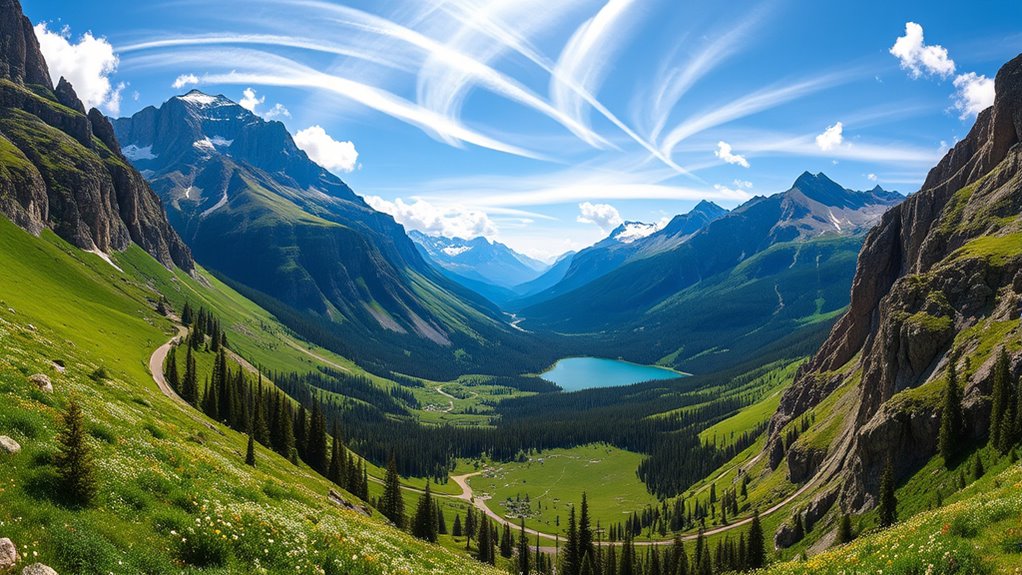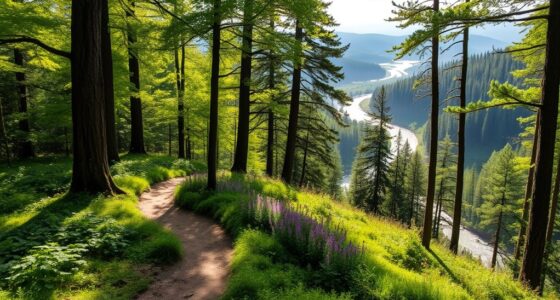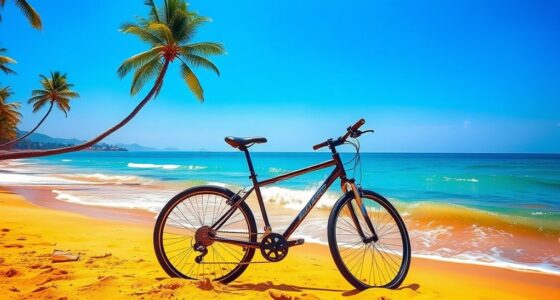Cycling Montana’s Going-to-the-Sun Road offers you jaw-dropping views of stunning glacial lakes, towering mountains, and vibrant wildlife. You’ll ascend through diverse landscapes, encountering breathtaking spots like Lake McDonald and Logan Pass. This 50-mile scenic drive combines natural beauty with remarkable engineering history, transporting you through alpine meadows and dense forests. But there’s more to the experience. Discover essential tips and points of interest that will make your journey unforgettable.
Key Takeaways
- Experience breathtaking views of glacial lakes, waterfalls, and diverse wildlife while cycling along the 50-mile Going-to-the-Sun Road.
- The route features stunning landmarks like Lake McDonald and Logan Pass, revealing the majestic Continental Divide.
- Enjoy vehicle-free cycling opportunities in late spring, enhancing the serene experience of the scenic drive.
- Key points of interest, such as Apgar Village and Weeping Wall, provide unique stops during your cycling adventure.
- Prepare for changing weather conditions and wildlife encounters by packing essential gear like helmets and bear spray.
The Spectacular Journey Begins

As you embark on your adventure along Going-to-the-Sun Road, you’ll quickly realize that this 50-mile stretch in Glacier National Park is more than just a scenic drive; it’s a breathtaking journey through nature’s masterpiece.
Connecting West Glacier and St. Mary, the route showcases stunning glacial lakes, cascading waterfalls, and expansive alpine landscapes. Key landmarks like Lake McDonald, Logan Pass, and St. Mary Lake offer perfect spots to pause and soak in the views.
As you ascend to Logan Pass, watch for the changing weather and diverse wildlife, including majestic cedar forests and hemlock groves.
An Engineering Marvel: The Road’s History

While you navigate the stunning curves of Going-to-the-Sun Road, it’s hard to believe the incredible engineering challenges that were overcome to create this iconic route.
Established in 1910, the road’s planning began with George Goodwin’s 1918 proposal and saw significant collaboration between the National Park Service and the Bureau of Public Roads.
Construction faced steep mountains, severe weather, and high labor turnover due to the harsh conditions. Engineers used meticulous surveying and small blasts to preserve the landscape while building impressive structures like tunnels and Triple Arches.
Officially opened on July 15, 1933, this marvel of engineering not only emphasizes environmental sensitivity but also showcases the determination and ingenuity of its creators in overcoming obstacles to achieve a stunning scenic drive.
Cycling the Scenic Route
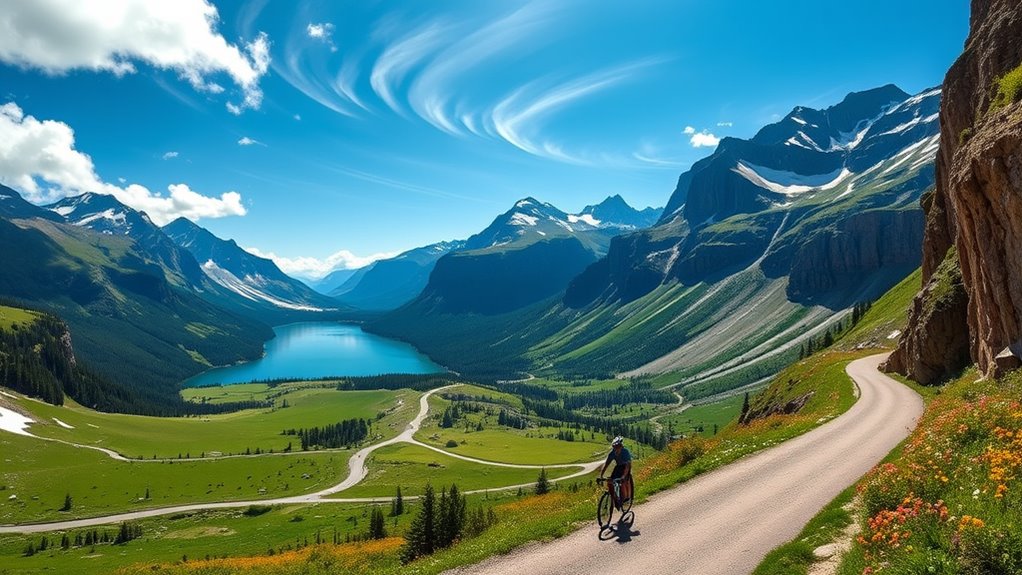
Cycling the Going-to-the-Sun Road offers an unparalleled way to experience the breathtaking beauty of Glacier National Park. As you pedal along, you’ll be treated to stunning views of rushing rivers, majestic waterfalls, and towering mountain vistas.
The diverse landscapes, from lush alpine meadows to dense forests, create a picturesque backdrop for your journey. Don’t miss Logan Pass at 6,646 feet, where the Continental Divide reveals its grandeur.
Keep your eyes peeled for mountain goats and bighorn sheep, often seen along the route. The Weeping Wall, especially dramatic during spring snowmelt, is a highlight.
Late spring, when the road is open to cyclists and closed to cars, provides the perfect opportunity to enjoy this scenic ride without the crowds.
Must-See Points of Interest

Exploring the Going-to-the-Sun Road reveals a treasure trove of must-see points of interest that enhance your cycling adventure.
Start at Lake McDonald, where the views during sunrise and sunset are simply breathtaking.
Stop by Apgar Village for a snack or some ice cream before heading to the historic Lake McDonald Lodge, featuring fascinating taxidermy collections.
Don’t miss The Loop, a famous hairpin turn offering stunning views of Heavens Peak.
The Weeping Wall is another unique spot, showcasing a seasonal waterfall cascading right onto the road.
Each of these locations not only adds to your ride but also provides unforgettable experiences that encapsulate the beauty of Glacier National Park.
Make sure to take it all in!
Wildlife Encounters and Safety Tips
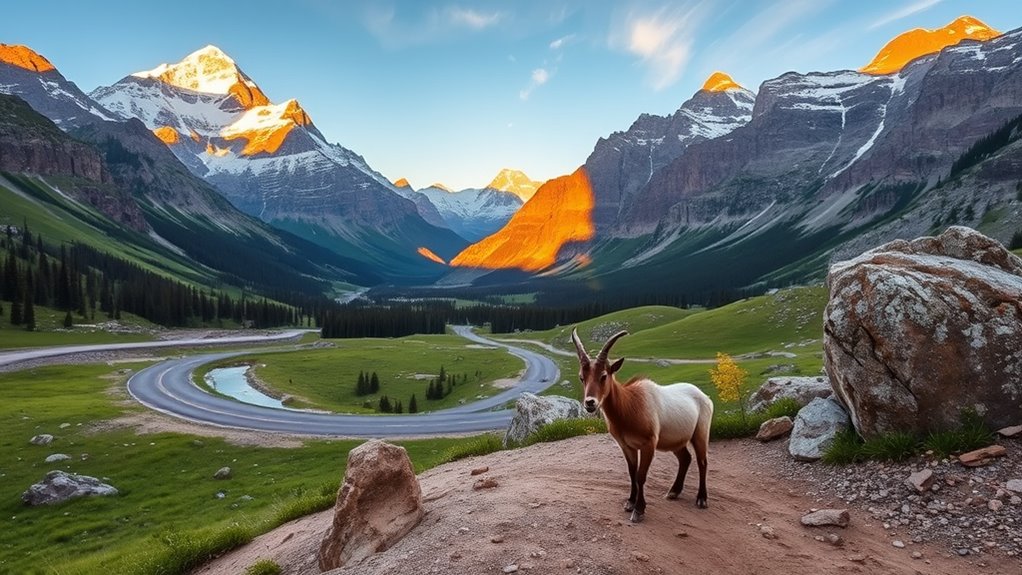
As you navigate the breathtaking Going-to-the-Sun Road, you’re likely to encounter a variety of wildlife that calls Glacier National Park home.
Keep an eye out for mountain goats and bighorn sheep near Logan Pass, while marmots and pikas can be spotted along the trails. If you’re lucky, you might even see elusive wolves in remote areas.
To ensure a safe experience, stay calm and keep your distance from wildlife; sudden movements can startle them.
Never feed animals, as this disrupts their natural behavior. Make noise while hiking to avoid surprising them, and always carry bear spray in bear country.
Seasonal Considerations for Cyclists

While planning your ride on Going-to-the-Sun Road, it’s essential to consider the seasonal conditions that can significantly impact your experience.
Spring offers a unique opportunity for cyclists, as the road is usually closed to vehicles during plowing, which starts in April. You can ride as far as the plows have cleared, but keep an eye on weather variability and potential avalanche closures.
Spring presents a special chance for cyclists, with vehicle access limited during plowing, allowing rides as far as the cleared road.
From late April to early July, you’ll enjoy fewer crowds, while summer brings restrictions from 11 am to 4 pm.
Fall riding is unrestricted until mid-October, but be prepared for snow.
Always check the park’s website for updates on road conditions, and pack layers, snacks, and water for unpredictable weather. Additionally, consider investing in a portable camping toilet for added convenience during your ride.
Enjoy the journey!
Parking and Accessibility Challenges

Parking and accessibility pose significant challenges for cyclists on Going-to-the-Sun Road.
Parking lots fill up quickly at popular spots like Avalanche Lake and Apgar, especially during peak season. If you’re planning to drive, consider renting bike racks to transport your bike to the start.
Shuttle services are available from Glacier Outfitters in Apgar, which can help you bypass some road closures. Keep in mind that the road is narrow without shoulders, making it tricky to navigate, especially during peak hours when bikes are restricted.
Be prepared for road closures due to maintenance and plowing, and always prioritize safety. Bring essential gear like helmets and bear spray, and stay alert for changing weather conditions.
Embracing the Cultural Significance

Understanding the cultural significance of Going-to-the-Sun Road enriches your experience as you explore this iconic route.
The road honors the Blackfeet Native American tribe, whose sacred mountains, known as “Mistakis,” surround you. As you ride, appreciate the historical context: this road reflects the early American park movement and its engineering marvels, crossing the Continental Divide at Logan Pass.
You’ll notice the NPS Rustic style of structures, designed to blend with the landscape. Engage with the local culture, where peace ceremonies once brought together the Blackfeet and Kootenai tribes.
Feel the spirit of community and tradition, knowing that the road is a living testament to the rich heritage and natural beauty of this incredible area. Developing cultural intelligence (CQ) enhances your understanding and appreciation of the diverse cultures that shape this landscape.
Preparing for an Unforgettable Experience

How can you ensure your ride along Going-to-the-Sun Road is truly unforgettable? Start by checking road conditions; it’s typically open from mid-June to early October.
Be mindful of vehicle traffic, especially during peak season, and pack layers for fluctuating weather. Don’t forget your safety gear—helmets and reflective clothing are essential.
Prepare physically for the challenging 50-mile route with its climbs and descents. Plan your route by including must-see stops like Logan Pass, and utilize designated pull-outs for breaks.
Stock up on supplies before entering the park, as services are limited. Finally, consider renting bikes from local shops and use the free shuttle service for easier access. Additionally, knowing the local business hours of nearby fitness centers can help you stay active during your trip.
Prepare well, and you’ll create lasting memories on this breathtaking journey!
Frequently Asked Questions
What Is the Best Time to Visit for Cycling?
The best time to visit for cycling is in late spring, before the road opens fully to vehicles.
You’ll enjoy a peaceful ride with fewer crowds, but be prepared for unpredictable weather. Starting early in the morning can help you avoid traffic once the road opens.
Make sure to check road conditions and pack appropriate gear, including layers for changing temperatures and bear spray for safety.
Enjoy the stunning scenery along the way!
Are There Any Guided Cycling Tours Available?
Yes, there are guided cycling tours available that cater to different preferences.
You can choose from options lasting 5-8 hours, with experienced guides prioritizing your safety and comfort. Tours often include e-bikes, scenic overlooks for photos, and even opportunities to see wildlife.
Customizable routes allow you to explore at your own pace, and some tours provide meals to enjoy amidst breathtaking views.
Reservations are recommended, so plan ahead for an unforgettable experience.
Can I Rent a Bike Near the Road?
Biking bliss beckons! Yes, you can definitely rent a bike near the road. Options like Montana E-Bikes and AllTrips offer a variety of e-bikes perfect for your adventure.
You’ll find convenient rental locations in Whitefish and Apgar Village, ensuring easy access. Prices typically range from $25 to $39 per day, making it affordable to explore.
Just remember to check seasonal availability and stay prepared for changing weather while you ride!
What Should I Bring for a Day of Cycling?
For a day of cycling, you should pack essential gear like a properly tuned bike, helmet, and spare tube for flats.
Don’t forget bear spray and a first aid kit for safety. Bring plenty of water to stay hydrated and energy bars for nutrition.
Wear comfortable cycling shorts and gloves, and consider reflective gear for visibility.
Lastly, check the weather and plan your route to ensure a smooth ride.
Are There Restroom Facilities Along the Route?
If you’re planning a trip along the route, you’ll find restroom facilities at key locations, including Logan Pass and Apgar Village.
Whether you need a quick stop at a pullout like Big Bend or a visitor center, restrooms are conveniently available.
During summer, they’re maintained regularly to ensure cleanliness and accessibility.
Just remember to plan ahead during peak times, as some areas might’ve limited services or no potable water.
Conclusion
As you pedal along the Going-to-the-Sun Road, let the breathtaking vistas wrap around you like a warm embrace. Each turn reveals nature’s masterpiece, where towering peaks kiss the sky and glacial lakes shimmer like jewels. Remember, this isn’t just a ride; it’s a journey through a living canvas of wild beauty. So, gear up and dive into this unforgettable experience, where every moment unfolds like a page from an adventure novel waiting to be written.
